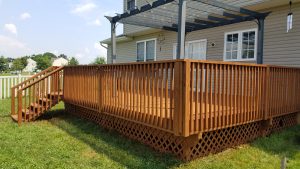When it come to stain, there are many options. This includes: solid stain, semi-transparent stain, semi-solid stain, and the high solids vs. low solids. And that's just for staining wood. We stain almost as much concrete as we do wood anymore. So, what makes stain different than paint? Stains are thinner than paint. Paint lays down 20% into the surface and 80% on top, making it great for a lot of surface contact. Stain on the other hand lays down 75% to 95% into the surface with only 5% to 25% on the surface. It still protects the surface, but in a different way and not quite as much as paint… but it allows the natural beauty to show.

Residential deck with a fresh coat of semi-transparent stain
Here are a few quick rules to make the decision a little easier:
Solid Stain - solid stains are opac and do not let the different colors in the wood show through. Since they are such thin coatings the full texture of the wood shows, but not the color variations. They go down 75-80% penetrating into the surface and 20-25% on the surface. They do block 100% of the sun's UV rays, therefore, making the job last longer... 3-5 years in most cases.

Solid stain applied to a residential deck
Semi-Transparent Stain - semi-transparent stains darken the surface, but let the natural color variations show through really well. They penetrate 80-95% into the surface and block about half of the sun’s UV rays. It typically lasts 1 to 2 years with full sun exposure before needing another coat applied. Some manufacturers (Sikkens) make a higher solids semi-transparent stain system that leave a 25% film on the surface to help block more UV rays which will last a year or 2 longer. However, if not maintained, these systems become more costly because they will need to be stripped. The film will delaminate and peel, where as the standard systems can just be rinsed and top coated when they fail.
Semi-Solid Stain - basically just like it sounds, half way between the solid stain and semi-transparent stain



